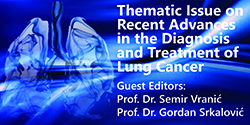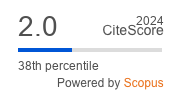A polymorphism in gasdermin B (GSDMB) gene is associated with severe asthma exacerbations in childhood: A population-based birth cohort study
Keywords:
Childhood asthma, Genetics, rs7216389, GSDMB, ORMDL3Abstract
Rationale. Markers on chromosome 17q12 have been associated withchildhood asthma in genome-wide association studies. Objective.We investigated the association of a single nucleotide polymorphism(SNP) in GSDMB (rs7216389) on 17q12 with asthma presence andseverity in a population-based birth cohort study. Methods. Childrenwere followed from birth to age 8 years. Data on parentally-reportedsymptoms were collected using an interviewer-administered questionnaireat age 1, 3, 5 and 8 years. Atopy was assessed by skin testing at age3, 5 and 8 years. Information on asthma/wheeze hospital admissionsand severe asthma exacerbations was collected from child’s primarycare medical record. Data were analyzed as a recessive genetic model,with T-allele homozygotes as the risk group. Results. Compared to Callele carriers, T-allele homozygotes of rs7216389 were signifi cantlymore likely to: wheeze at age 3, 5 and 8 years; have persistent wheeze(OR 1.69, 95% CI 1.05-2.71, p=0.03); have frequent episodes of wheezingand be on asthma medication. In a multiple logistic regressionmodel adjusted for gender, atopic sensitisation and maternal smoking,T allele homozygotes were signifi cantly more likely to be hospitalized(aOR 2.20 [1.22-3.99], p=0.0009) with Cox regression hazard ratiofor T-allele homozygotes of 1.94 [1.13-3.33], p=0.016. Results of Coxregression analysis investigating the eff ect of genotype on the age offi rst severe exacerbation of asthma indicated an overall hazard ratioof severe asthma exacerbation among T-allele homozygotes of 1.53[1.04-2.27], p=0.03. Conclusions. Th is is the fi rst population-basedbirth cohort study to confi rm that the risk of childhood wheeze andsevere asthma/wheeze exacerbations is increased among rs7216389TT homozygotes.References
Duff y DL, Martin NG, Battistutta D, Hopper JL, Mathews JD. Genetics of asthma and hay fever in Australian twins. Am Rev Respir Dis. 1990; 142:1351-8.
Ober C, Hoffj an S. Asthma genetics 2006: the long and winding road to gene discovery. Genes Immun. 2006;7:95-100.
Moff att MF, Kabesch M, Liang L, Dixon AL, Strachan D, Heath S, et al. Genetic variants regulating ORMDL3 expression contribute to the risk of childhood asthma. Nature. 2007;448:470-3.
Tamura M, Tanaka S, Fujii T, Aoki A, Komiyama H, Ezawa K, et al. Members of a novel gene family, Gsdm, are expressed exclusively in the epithelium of the skin and gastrointestinal tract in a highly tissue-specifi c manner. Genomics. 2007;89:618-29.
Saeki N, Usui T, Aoyagi K, Kim DH, Sato M, Mabuchi T, et al. Distinctive expression and function of four GSDM family genes (GSDMA-D) in normal and malignant upper gastrointestinal epithelium. Genes Chromosomes Cancer. 2009;48:261-71.
Hjelmqvist L, Tuson M, Marfany G, Herrero E, Balcells S, Gonzalez-Duarte R. ORMDL proteins are a conserved new family of endoplasmic reticulum membrane proteins. Genome Biol 2002; 3:RESEARCH0027.
Galanter J, Choudhry S, Eng C, Nazario S, Rodriguez- Santana JR, Casal J, et al. ORMDL3 gene is associated with asthma in three ethnically diverse populations. Am J Respir Crit Care Med. 2008;177:1194-200.
Hirota T, Harada M, Sakashita M, Doi S, Miyatake A, Fujita K, et al. Genetic polymorphism regulating ORM1-like 3 (Saccharomyces cerevisiae) expression is associated with childhood atopic asthma in a Japanese population. J Allergy Clin Immunol. 2008;121:769-70.
Madore AM, Tremblay K, Hudson TJ, Laprise C. Replication of an association between 17q21 SNPs and asthma in a French-Canadian familial collection. Hum Genet 2008;123:93-5.
Leung TF, Sy HY, Ng MC, Chan IH, Wong GW, Tang NL, et al. Asthma and atopy are associated with chromosome 17q21 markers in Chinese children. Allergy. 2009;64:621-8.
Wu H, Romieu I, Sienra-Monge JJ, Li H, del Rio-Navarro BE, London SJ. Genetic variation in ORM1-like 3 (ORMDL3) and gasderminlike (GSDML) and childhood asthma. Allergy.
;64:629-35.
Tavendale R, Macgregor DF, Mukhopadhyay S, Palmer CN. A polymorphism controlling ORMDL3 expression is associated with asthma that is poorly controlled by current medications. J Allergy Clin Immunol. 2008;121:860-3.
Bisgaard H, Bonnelykke K, Sleiman PM, Brasholt M, Chawes B, Kreiner-Moller E, et al. Chromosome 17q21 gene variants are associated with asthma and exacerbations but not atopy in early childhood. Am J Respir Crit Care Med. 2009;179:179-85.
Custovic A, Simpson BM, Murray CS, Lowe L, Woodcock A. Th e National Asthma Campaign Manchester Asthma and Allergy Study. Pediatr Allergy Immunol. 2002; 13 Suppl 15:32-7.
Lowe L, Murray CS, Custovic A, Simpson BM, Kissen PM, Woodcock A. Specifi c airway resistance in 3-year-old children: a prospective cohort study. Lancet. 2002;359:1904-8.
Lowe L, Murray CS, Martin L, Deas J, Cashin E, Poletti G, et al. Reported versus confi rmed wheeze and lung function in early life. Arch Dis Child. 2004; 89:540-3.
Murray CS, Woodcock A, Smillie FI, Cain G, Kissen P, Custovic A. Tobacco smoke exposure, wheeze, and atopy. Pediatr Pulmonol. 2004;37:492-8.
Nicolaou N, Poorafshar M, Murray C, Simpson A, Winell H, Kerry G, et al. Allergy or tolerance in children sensitized to peanut: prevalence and differentiation using component-resolved diagnostics. J Allergy Clin Immunol. 2010;125:191-7e1-13.
Lowe LA, Simpson A, Woodcock A, Morris J, Murray CS, Custovic A. Wheeze phenotypes and lung function in preschool children. Am J Respir Crit Care Med. 2005;171:231-7.
Martinez FD, Wright AL, Taussig LM, Holberg CJ, Halonen M, Morgan WJ. Asthma and wheezing in the fi rst six years of life. Th e Group Health Medical Associates. N Engl J Med. 1995;332:133-8.
Nicolaou NC, Simpson A, Lowe LA, Murray CS, Woodcock A, Custovic A. Day-care attendance, position in sibship, and early childhood wheezing: a population-based birth cohort study. J Allergy Clin Immunol. 2008;122:500-6 e5.
Reddel HK, Taylor DR, Bateman ED, Boulet LP, Boushey HA, Busse WW, et al. An offi cial American Th oracic Society/European Respiratory Society statement: asthma control and exacerbations: standardizing endpoints for clinical asthma trials and clinical practice. Am J Respir Crit Care Med.
;180:59-99.
Bray MS, Boerwinkle E, Doris PA. High-throughput multiplex SNP genotyping with MALDI-TOF mass spectrometry: practice, problems and promise. Hum Mutat. 2001;17:296-304.
Yang H, Wang H, Wang J, Cai Y, Zhou G, He F, et al. Multiplex single-nucleotide polymorphism genotyping by matrix-assisted laser desorption/ionization time-of-fl ight mass spectrometry. Anal Biochem. 2003;314:54-62.
Tost J, Gut IG. Genotyping single nucleotide polymorphisms by mass spectrometry. Mass Spectrom Rev. 2002;21:388-418.
Custovic A, Simpson BM, Simpson A, Kissen P, Woodcock A. Eff ect of environmental manipulation in pregnancy and early life on respiratory symptoms and atopy during fi rst year of life: a randomised trial. Lancet. 2001;358:188-93.
Simpson A, Simpson B, Custovic A, Craven M, Woodcock A. Stringent environmental control in pregnancy and early life: the long-term eff ects on mite, cat and dog allergen. Clin Exp Allergy. 2003;33:1183-9.
Woodcock A, Lowe LA, Murray CS, Simpson BM, Pipis SD, Kissen P, et al. Early life environmental control: eff ect on symptoms, sensitization, and lung function at age 3 years. Am J Respir Crit Care Med. 2004;170:433-9.
Moff att MF, Gut IG, Demenais F, Strachan DP, Bouzigon E, Heath S, et al. A large-scale, consortium-based genomewide association study of asthma. N Engl J Med. 2010;363:1211-21.
Brand PL, Baraldi E, Bisgaard H, Boner AL, Castro- Rodriguez JA, Custovic A, et al. Defi nition, assessment and treatment of wheezing disorders in preschool children: an evidence-based approach. Eur Respir J. 2008;32:1096-110.
Halapi E, Gudbjartsson DF, Jonsdottir GM, Bjornsdottir US, Th orleifsson G, Helgadottir H, et al. A sequence variant on 17q21 is associated with age at onset and severity of asthma. Eur J Hum Genet. 2010;18:902-8.
Binia A, Khorasani N, Bhavsar PK, Adcock I, Brightling CE, Chung KF, et al. Chromosome 17q21 SNP and severe asthma. J Hum Genet. 2011;56:97-8.
Cantero-Recasens G, Fandos C, Rubio-Moscardo F, Valverde MA, Vicente R. Th e asthma-associated ORMDL3 gene product regulates endoplasmic reticulum-mediated calcium signaling and cellular stress. Hum Mol Genet. 2010;19:111-21.
Zhang K, Kaufman RJ. From endoplasmic-reticulum stress to the infl ammatory response. Nature. 2008;454:455-62.
Lluis A, Schedel M, Liu J, Illi S, Depner M, von Mutius E, et al. Asthma-associated polymorphisms in 17q21 infl uence cord blood ORMDL3 and GSDMA gene expression and IL-17 secretion. J Allergy Clin Immunol. 2011;127:1587-94 e6.
Chatila TA, Li N, Garcia-Lloret M, Kim HJ, Nel AE. T-cell eff ector pathways in allergic diseases: transcriptional mechanisms and therapeutic targets. J Allergy Clin Immunol. 2008;121:812-23; quiz 24-5.
Wang YH, Wills-Karp M. Th e Potential Role of Interleukin-17 in Severe Asthma. Curr Allergy Asthma Rep. 2011;11:388-94
Nalls MA, Couper DJ, Tanaka T, van Rooij FJ, Chen MH, Smith AV, et al. Multiple Loci are associated with white blood cell phenotypes. PLoS Genet. 2011;7:e1002113.






